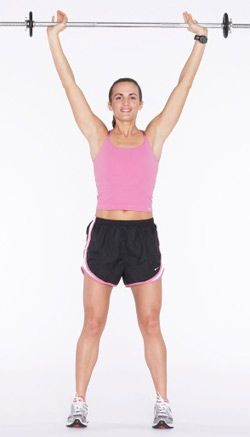|
|
|
 , ,
Font size |
Overhead Press: Exercise to Prevent Shoulder Girdle Injury

Rushing to perform overhead
squats can lead to shoulder injury, development of
shoulder strength and coordination first is critical, along with having a
competent front squat.
The shoulder girdle consists primarily of the scapula bone and the clavicle
bone or collar bone which move together as a unit. The shoulder girdle muscle
are those which attach to and move these two bones. They are trapezius muscle,
Serratus Anterior, Rhomboids, Pectoralis Minor, Levator Scapulae and the
Sternocleidomastoid.
The press, push press, push jerk, snatch, and overhead squat all require a
specific level of
shoulder mobility before you should perform them under any significant load.
If these movements are performed with an improper range of motion, then they can
cause significant damage to your
shoulder while simultaneously setting your back and hips up for disaster,
too. The best way to prevent
injuries is to do overhead pressing.
Overhead Pressing
-
Hold the bar (independent of weights) on your front shoulders and stand
shoulder width apart. Hands should never touch your shoulders.
-
Gripping the bar close to your wrist, in the base of your palm. Do not
close to your fingers.
-
Press the bar overhead in a straight line. Unfortunately your head is in
the way. So you�ll need to move your head & torso during the Overhead Press.
-
Press until your elbows are locked. Then shrug your traps for extra
support.
-
Hold for a second and travel back to your shoulder.
-
Once you have mastered the exercise without weight, begin loading.
Once the overhead press is mastered, you can add load and speed with the push
press. After the push press is a smooth and coordinated movement, you can
progress into the push jerk. When the push jerk becomes a natural movement, then
learning the overhead squat is next.
Developing overhead stability is a combination of establishing enough
muscle
flexibility, joint mobility, trigger point reduction, and stability. Focus
on building and maintaining good
posture.
Note:
-
Start each rep with elbows in front of the bar & chest up.
-
The higher the bar on your chest, the shorter the distance it has to
travel. Put the bar close to your clavicles.
-
Quickly tilt your head back & forth. Clavicles might hurt at first, your
skin will adapt & thicken.
-
Go Forward. You�ll miss reps if you stay back vs. getting under the bar.
-
Shift your torso forward when the bar reaches forehead level.
-
If you breathe at the top, you can bounce the bar off your chest making
the next rep easier. Breathe at the bottom & you�ll press from a dead stop,
making the next rep harder. The former allows more weight. The latter makes
the exercise harder, making the former easier.
Benefits
-
 The Overhead Press works your body as one piece. Your trunk & legs
stabilize the weight while your shoulders, upper-chest & arms press the
weight overhead. The Overhead Press works your body as one piece. Your trunk & legs
stabilize the weight while your shoulders, upper-chest & arms press the
weight overhead.
-
Builds Muscle.
Abs &
back stabilize the weight. Shoulders, upper-chest & triceps press the
weight overhead.
-
The Overhead Press works all shoulder heads equally.
Dated 17 September 2014
Related Links
|
|
|
|
|









